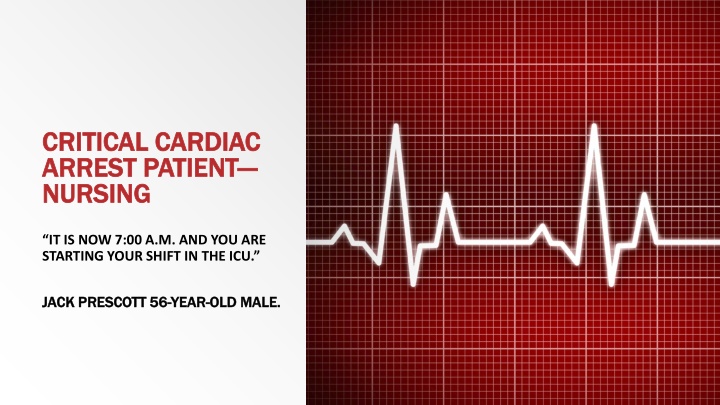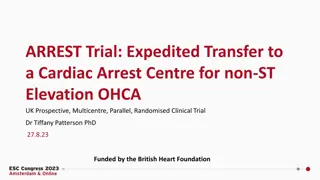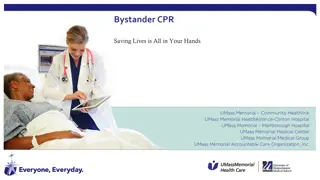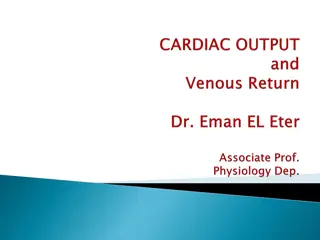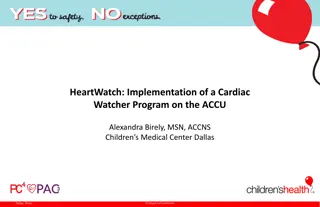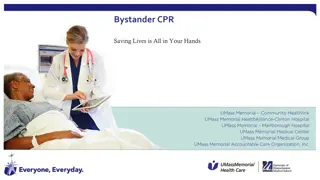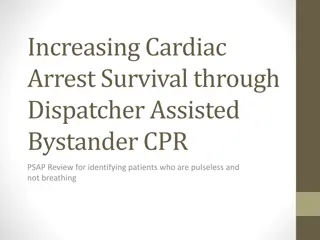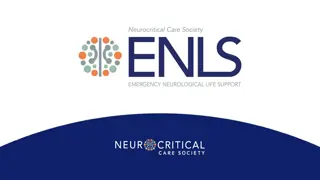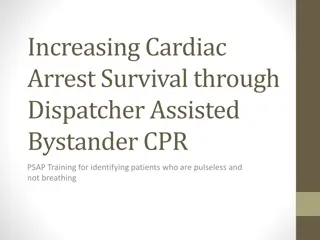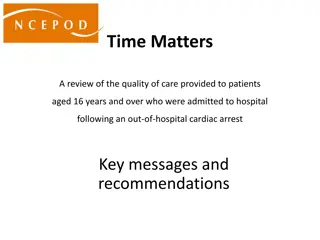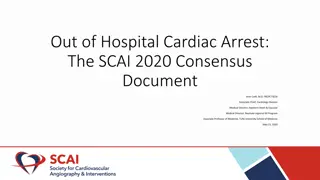Critical Cardiac Arrest Patient Nursing Scenario
In this scenario, you are starting your shift in the ICU with a critical cardiac arrest patient, Jack Prescott, a 56-year-old male. The learning objectives include recognizing septic patient symptoms, assessing hemodynamic status, initiating communication with a physician, and developing a care plan for critical patients. Key abbreviations and acronyms are provided for reference.
Download Presentation

Please find below an Image/Link to download the presentation.
The content on the website is provided AS IS for your information and personal use only. It may not be sold, licensed, or shared on other websites without obtaining consent from the author.If you encounter any issues during the download, it is possible that the publisher has removed the file from their server.
You are allowed to download the files provided on this website for personal or commercial use, subject to the condition that they are used lawfully. All files are the property of their respective owners.
The content on the website is provided AS IS for your information and personal use only. It may not be sold, licensed, or shared on other websites without obtaining consent from the author.
E N D
Presentation Transcript
CRITICAL CARDIAC CRITICAL CARDIAC ARREST PATIENT ARREST PATIENT NURSING NURSING IT IS NOW 7:00 A.M. AND YOU ARE STARTING YOUR SHIFT IN THE ICU. JACK PRESCOTT 56 JACK PRESCOTT 56- -YEAR YEAR- -OLD MALE. OLD MALE.
About this Scenario. This presentation is a supplemental resource for Healthcare Simulation Lab Scenario Information Form (SIF) titled: CRITICAL CARDIAC ARREST PATIENT NURSING INSTRUCTOR REFERENCE GUIDE Notice to Faculty and Students: Per the International Nursing Association for Clinical Simulation and Learning (INACSL) standard of best practice: Simulation Professional Integrity. All simulation content must be protected to assure confidentiality and integrity for future use. This content is published for the express use of faculty designing and implementing medical simulation activities. It is not intended for use by students participating in simulation activities. Any use of this content by students may be considered a violation of academic integrity standards. Before using this scenario, it is highly recommended that the educator consult with medical direction and/or a subject matter expert in their region. The procedures and protocols described in this scenario may not be appropriate for all healthcare systems and may require alteration to match procedures and protocols used in your area. Drug treatment recommendations and instructions were developed using information from New Mexico healthcare systems.
Learning Objectives and Goals. At the successful completion of this simulated scenario, students will be able to: Recognize signs and symptoms of decompensating septic patient. Fully assess patient including hemodynamic status and initiate SBAR communication with physician. Apply appropriate Nursing adjuncts to support including Medication Administration and achieving hemodynamic stability. Develop plan of care for critical patient.
Key to Abbreviations and Acronyms Key to Abbreviations and Acronyms Used in This Scenario. Used in This Scenario. ABG: Arterial Blood Gas. BID: Bis in Die (Twice a Day). BiPAP: Bilevel Positive Airway Pressure. BP: Blood Pressure. BUN: Blood Urea Nitrogen. cc: Cubic Centimeter. c/o: Complains Of. Cl: Chloride. CO2: Carbon Dioxide. Cr: Creatinine. CVP: Central Venous Pressure. ICU: Intensive Care Unit. ECG: Electrocardiogram. ED: Emergency Department. EMS: Emergency Medical Services. ETOH: Ethyl Alcohol (Ethanol). ETT: Endotracheal Tube. FIO2: Fraction of Inspired Oxygen. Gluc: Glucose. H&H: Hemoglobin and Hematocrit. HCO3 : Bicarbonate (negative ion). HR: Heart Rate. Hx: History. K: Potassium. IV: Intravenous. Kg: Kilogram. LOC: Loss of Consciousness. MAP: Mean Arterial Pressure. mg: Milligram. ml: Milliliter. Na: Natrium (Sodium). NIBP: Non-Invasive Blood Pressure. NS: Normal Saline. PaO2: Partial Pressure of Oxygen in Arterial Blood. PaCO2: Partial Pressure of Carbon Dioxide in Arterial Blood. PCO2: Partial Pressure of Carbon Dioxide. PEEP: Positive End-Expiratory Pressure. PH: Potential of Hydrogen (Acid-to-Base Ratio). PVC: Premature Ventricular Contractions. RASS: Richmond Agitation-Sedation Scale. RBC: Red Blood Cell. ROSC: Return of Spontaneous Circulation. RR: Respiratory Rate. RRT: Rapid Response Team. SBAR: Situation, Background, Assessment, Recommendation. WBC: White Blood Cell.
Jack Prescott 56 Jack Prescott 56- -Year Year- -Old Male. Old Male. Case Information and Initial Vital Signs: Jack Prescott is a 56-year-old male presented to ED yesterday (via EMS) c/o Abdominal pain and Left lower extremity pain during dialysis this a.m. Also reporting shortness of breath. He was admitted to the medical floor for cellulitis in the left calf with an open un-healing wound. Over the last 24, he has decompensated and an RRT was called on the floor for respiratory distress. The patient was placed on BiPAP and transported to the ICU. During the night he declined further, with a decreased level of consciousness and was hemodynamically unstable. He was intubated, placed on mechanical ventilation. A radial arterial line and Central line were placed. The patient was stabilized with fluid boluses and vasopressors. He is sedated. Patient is currently in the ICU on the vent: Vent Settings: Vol control: Vt 450, RR 22, PEEP 5, FIO2 60%. Vitals are: HR 103, BP 95/74, RR 22, SPO2 92%, Temp 38 Celsius. LOC: Sedated with RASS of -2.
Jack Prescott Jack Prescott Medical/Social History. Medical History: Diabetes Type 1 since 2007. Chronic renal failure requiring dialysis for the last 6 months. Hypertension. Obesity. Home Meds: Lantus, Metoprolol, Lasix, Xanax, Ambien, Oxycodone. Social History: Past Hx of ETOH abuse, sober for 2 years. Divorced/lives alone. 2 adult children living out of state. Code Status: Full Code No advanced directives on file.
Jack Prescott Jack Prescott: Orders. Complete critical care patient assessment including Hemodynamics. Draw Arterial Blood Gas. Draw labs from Central Line. Give SBAR Report to physician and request necessary nursing interventions to stabilize Mr. Prescott. Follow physician s orders as given. Develop follow-up plan of care.
Chem and CBC Labs in ICU at 12:00 Midnight. Na: 140. WBC: 18,000. K: 3.4. Lactate: 3.1. Cl: 94. ABGs: CO2: 20. PH: 7.23. BUN: 16. PCO2: 35. Cr: 3.2. PaO2: 64. Gluc: 216. HCO3 : 18 (with negative ion). H&H: 12/37. RBC: 3.8.
ABGs 2 Hours Ago Just Prior to Intubation. ABGs at 0500: PH: 7.13. PaCO2: 42. PaO2: 55. HCO3 : 14 (with negative ion). Lactate: 4.6.
CT of Abdomen Showing Free Air and Bowel Obstruction.
Acknowledgements. This workforce product was funded by a grant awarded by the U.S. Department of Labor s Employment and Training Administration. The product was created by the grantee and does not necessarily reflect the official position of the U.S. Department of Labor. The U.S. Department of Labor makes no guarantees, warranties, or assurances of any kind, express or implied, with respect to such information, including any information on linked sites and including, but not limited to, accuracy of the information or its completeness, timeliness, usefulness, adequacy, continued availability, or ownership. Although the authoring institution of this educational resource has made every effort to ensure that the information presented is correct, the institution assumes no liability to any party for any loss, damage, or disruption caused by errors or omissions. Except where otherwise noted, this work by SUN PATH Consortium/Santa Fe Community College is licensed under the Creative Commons Attribution 4.0 International License. To view a copy of this license, click on the following link: Creative Commons Licenses 4.0.
